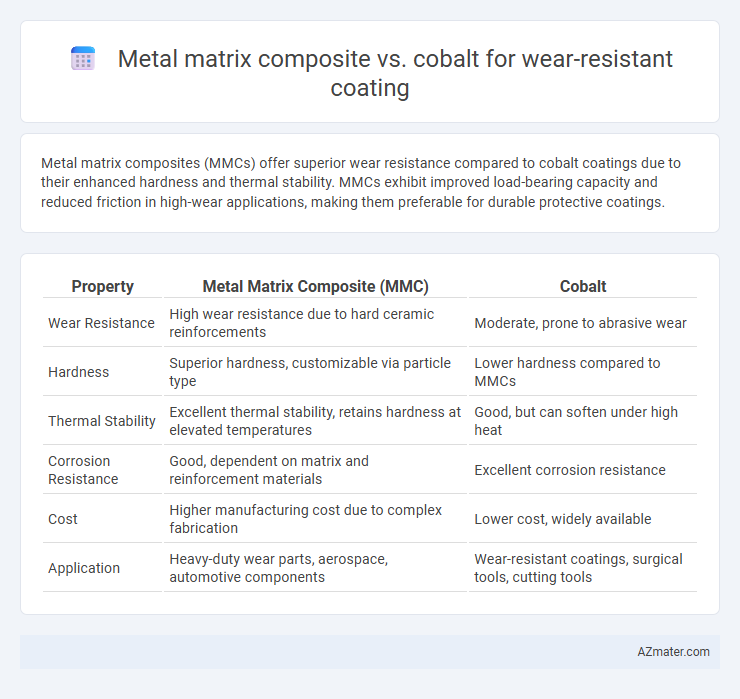Metal matrix composites (MMCs) offer superior wear resistance compared to cobalt coatings due to their enhanced hardness and thermal stability. MMCs exhibit improved load-bearing capacity and reduced friction in high-wear applications, making them preferable for durable protective coatings.
Table of Comparison
| Property | Metal Matrix Composite (MMC) | Cobalt |
|---|---|---|
| Wear Resistance | High wear resistance due to hard ceramic reinforcements | Moderate, prone to abrasive wear |
| Hardness | Superior hardness, customizable via particle type | Lower hardness compared to MMCs |
| Thermal Stability | Excellent thermal stability, retains hardness at elevated temperatures | Good, but can soften under high heat |
| Corrosion Resistance | Good, dependent on matrix and reinforcement materials | Excellent corrosion resistance |
| Cost | Higher manufacturing cost due to complex fabrication | Lower cost, widely available |
| Application | Heavy-duty wear parts, aerospace, automotive components | Wear-resistant coatings, surgical tools, cutting tools |
Introduction to Wear-Resistant Coatings
Wear-resistant coatings enhance surface durability by reducing abrasion, erosion, and friction in industrial applications. Metal matrix composites (MMCs) integrate ceramic reinforcements within a metallic base, providing superior hardness and thermal stability compared to traditional cobalt-based coatings. Cobalt coatings, known for their toughness and corrosion resistance, often fall short against the high wear rates MMCs can withstand in harsh environments.
Overview of Metal Matrix Composites (MMC)
Metal Matrix Composites (MMCs) are engineered materials combining a metal matrix with ceramic or other reinforcing phases to enhance wear resistance, strength, and thermal stability. Common matrices include aluminum, titanium, and magnesium alloys, reinforced with carbides, oxides, or whiskers to improve hardness and reduce friction under high-wear conditions. MMC coatings provide superior performance compared to cobalt-based coatings due to their tailored microstructure and ability to maintain mechanical integrity in extreme environments.
Properties of Cobalt-Based Coatings
Cobalt-based coatings exhibit exceptional wear resistance due to their high hardness, excellent corrosion resistance, and superior thermal stability, making them suitable for harsh environments. These coatings also provide excellent adhesion and fatigue resistance, which enhances their durability in high-stress applications. Compared to metal matrix composites, cobalt-based coatings offer a balanced combination of toughness and hardness, leading to prolonged service life in wear-intensive conditions.
Wear Resistance Mechanisms: MMC vs. Cobalt
Metal matrix composites (MMCs) exhibit superior wear resistance compared to cobalt coatings due to the reinforcement of hard ceramic particles like carbides or oxides within the metal matrix, which enhances load-bearing capacity and resists abrasive wear. Cobalt coatings primarily rely on their inherent toughness and strain hardening to provide wear resistance but lack the high hardness contributed by MMC reinforcements, resulting in lower resistance to abrasive and adhesive wear. The particulate reinforcements in MMCs hinder plastic deformation and crack propagation, leading to improved durability under harsh wear conditions compared to the more ductile cobalt coatings.
Comparative Hardness and Toughness
Metal matrix composites (MMCs) generally exhibit higher hardness compared to cobalt-based coatings, making them more effective in resisting abrasive wear. Cobalt coatings offer superior toughness, providing better resistance to impact and crack propagation under harsh operating conditions. The optimal wear-resistant coating choice depends on balancing the MMCs' hardness with cobalt's toughness based on specific application demands.
Corrosion Resistance: MMC versus Cobalt Alloys
Metal Matrix Composites (MMCs) exhibit superior corrosion resistance compared to cobalt alloys due to their reinforced ceramic particles that inhibit corrosive element penetration. The heterogeneous microstructure of MMCs reduces galvanic corrosion risks commonly observed in cobalt-based coatings. Enhanced chemical stability in aggressive environments makes MMCs a preferred choice for wear-resistant coatings requiring prolonged corrosion resistance.
Performance in High-Temperature Environments
Metal matrix composites (MMCs) exhibit superior wear resistance and thermal stability compared to cobalt-based coatings in high-temperature environments, thanks to their reinforced ceramic particles that enhance hardness and reduce thermal deformation. Cobalt coatings, while offering good toughness and corrosion resistance, tend to soften and oxidize at elevated temperatures above 600degC, limiting their efficacy in extreme heat applications. MMCs maintain hardness and sliding wear resistance up to 1000degC, making them ideal for aerospace, automotive, and industrial machinery exposed to prolonged thermal stress.
Cost Analysis and Material Availability
Metal matrix composites (MMCs) offer a cost-effective alternative to cobalt-based coatings due to their lower raw material prices and ease of manufacturing, significantly reducing overall production expenses. Cobalt, while providing superior wear resistance, is limited by high material costs and supply chain volatility caused by geopolitical factors and mining restrictions. The abundant availability of aluminum and ceramic reinforcements in MMCs ensures a more stable market supply, making MMC coatings a financially viable option for large-scale wear-resistant applications.
Industrial Applications and Case Studies
Metal matrix composites (MMCs) demonstrate superior wear resistance compared to cobalt-based coatings in heavy industrial applications such as mining and aerospace, where extended component life and reduced maintenance are critical. Case studies reveal that MMC coatings significantly enhance performance in high-friction environments by providing improved hardness, thermal stability, and corrosion resistance over cobalt alloys. Industries utilizing MMC wear-resistant coatings report substantial cost savings and downtime reduction due to their ability to withstand abrasive and erosive conditions more effectively than traditional cobalt coatings.
Conclusion: Selecting the Optimal Wear-Resistant Coating
Metal matrix composites (MMCs) offer superior wear resistance due to their combination of high hardness reinforcements and metallic toughness, making them ideal for applications requiring enhanced durability and thermal stability. Cobalt-based coatings provide excellent wear resistance with strong adhesion and corrosion resistance but may fall short in extreme abrasive environments compared to MMCs. Selecting the optimal wear-resistant coating depends on balancing factors such as operating conditions, load, temperature, and cost, with MMCs generally preferred for high-performance, heavy-wear applications and cobalt favored for moderate wear and corrosion resistance needs.

Infographic: Metal matrix composite vs Cobalt for Wear-resistant coating
 azmater.com
azmater.com